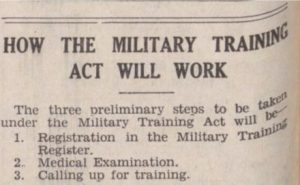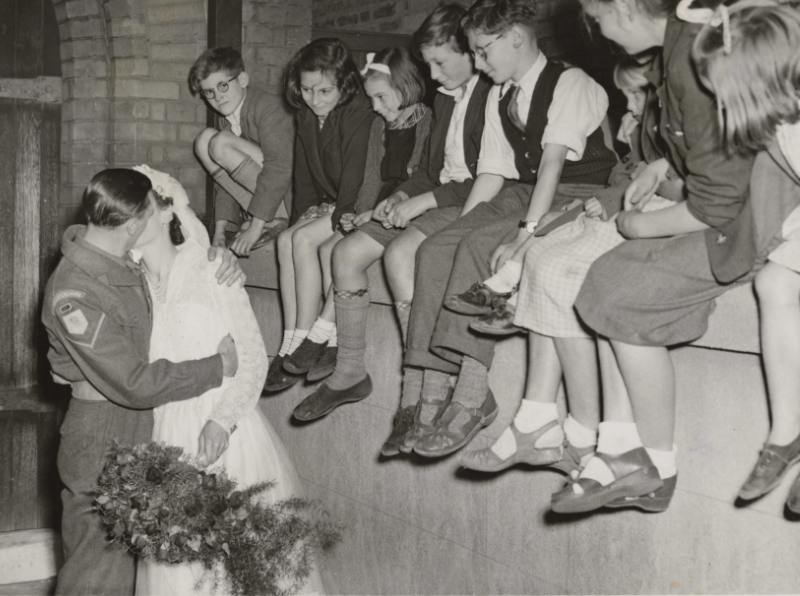Not long out of a prisoner of war camp in Korea, Fred Simpson returns home to marry his fiance. However, there’s more to this photo than meets the eye. Read on as we unpick the story of a man who was a prisoner of war in two wars.
On 10 October 1953, the bells of St. Antholin’s Church rang out into the air of Peckham, south London, as Fred Simpson tied the knot with his fiancee, Alice Mico. A photo of the couple’s union, pictured above, shows Fred in a British Army uniform, with his insignia revealing that he was a lance corporal with the Gloucestershire Regiment. What the photo doesn’t tell us is that Fred had not long returned from Korea, having been held as a prisoner of war for over two years. Who was this man, and what was his story?
Fred joins the army
Born in Peckham in 1920, Fred, as he was known, began his association with the armed forces in the 1930s when he joined the Territorial Army. As a part-time volunteer soldier, Fred was obliged to complete regular drills and attend an annual camp. Recruits could join as young as 17 and enlisted for four years; in times of emergency, they would be called up to boost the ranks of the regular army. Serving with the Queen’s Royal West Surrey Regiment, he was discharged on 24 January 1938.
With the clouds of war looming, Frederick re-enlisted on 4 April 1939, once more joining the Queens. The following month the government passed the Military Training Act, requiring all single men aged between 20 and 22 to complete six months of military training.

The Second World War
Fred joined the 1/6th Battalion of the Queens, a Territorial battalion which, when war broke out, was stationed in London to support the Metropolitan Police. The battalion saw service in Belgium in the early stages of the war and was subsequently evacuated home via Dunkirk following the Battle of France in May/June 1940.
Forming part of the 44th Home Counties Division, Fred and his comrades would have to wait until 1942 until they were sent overseas on active service again – their destination: the deserts of North Africa. The Allies had been battling with Axis Forces in the region since Italy’s entry into the war in June 1940. The fighting reached a peak at the Second Battle of El Alamein (23 October-4 November 1942), when Allied forces achieved a decisive victory over the Italian and German armies. The 1/6th Battalion Queens suffered heavy casualties during the fighting, including Fred.
FWR Tip: The term casualty is often used to describe those who were wounded, missing and prisoners of war, in addition to personnel who were killed in action.
According to our WWII Daily Reports collection, comprising reports on casualties at different stages of the war, Fred was deemed ‘Missing‘ on 25 October 1942, as per a report to the War Office Casualty Section made on 19 December 1942.
By April of the following year, War Office Casualty Section reports confirmed that Fred was a prisoner of war, having been captured in the Western Desert. We delved into our extensive collection of prisoner of war records to learn more.
Fred was initially held in Italy, at camp 70, in ‘Monturano’ (Monte Urano, in the province of Fermo on the east coast). In early September 1943, the Allies invaded mainland Italy, forcing the latter to surrender. While many Allied prisoners escaped (some sources suggest up to 17,000 of the 70,000 prisoners incarcerated in Italy), 50,000 were transferred to camps in Germany and German-occupied Europe, including Fred.
We know that in 1945 Fred was incarcerated at Stalag IV-G based on an entry in our fascinating British and Allied Prisoners of War held in Germany, 1945 collection. This is echoed in our Allied Prisoners of War, 1939-1945 collection too.

The HQ of Stalag IV-G was located in Oschatz, Saxony. The April 1945 edition of Prisoner of War, a monthly wartime magazine produced by the Red Cross, shed further light on the camp. Stalag IV-G had 64 British working detachments in the Stalag area, containing 4,055 British prisoners of war. You can access other editions of the magazine in our Historical Documents Library.
FWR Tip: For a detailed look at our Allied Prisoners of War, 1939-1945 collection and how to research WWII POWs, check out our blog: ‘Researching a WWII prisoner of war: how our Allied Prisoners of War, 1939-1945 collection can help you‘.
Fred was repatriated to England following the end of the war in Europe on 8 May 1945. He transferred to the Hampshire Regiment in March 1946 and subsequently onto the Army Reserve, liable for call-up pending any future emergencies.
War in Korea
Almost five years had passed since the end of WWII when North Korean forces invaded South Korea in June 1950, igniting the Korean War. As a reservist, Fred was called up for service with the British Army, which sent troops to Korea under the banner of the United Nations. As an experienced soldier of WWII, one wonders what Fred thought of being called up for service in another war.
Fred found himself amongst the ranks of the 1st Battalion Gloucestershire Regiment, which arrived in Korea in December 1950 and was soon involved in actions against North Korean and Chinese forces. By the following spring, the Glosters were in the region of the Imjin River, covering the approach to Seoul; they would be pushed to the limit during the Battle of the Imjin River (22-25 April 1951).
The battle commenced when the Chinese People’s Volunteer Army launched their Spring Offensive, crossing the Imjin River and attacking UN Forces, which included the 1st Battalion Gloucestershire Regiment, part of the 29th British Independent Infantry Brigade Group. Despite holding back the offensive, UN forces were soon overwhelmed and ordered to pull back. The Glosters remained in position but were surrounded. The battalion suffered 622 casualties, with 522 taken prisoner. In total, the Brigade sustained 1,091 casualties in what was the costliest battle for the British Army since WWII. The Daily Mirror published a casualty list shortly after the battle on 5 May, naming Fred amongst the missing men of the Glosters.

Delving into our Korea – British Army Prisoners of War collection, we discovered that Fred was amongst the prisoners captured on 26 April 1951, following the fighting at the Imjin River.
During Fred’s time in captivity, he was forced to write hundreds of times: ‘I will be a good boy. I will be a Communist.’ He was repatriated following the signing of the armistice in July 1953 and, as we know, married Alice on 10 October of that year.
FWR Tip: Did your ancestor serve during the Korean War? They may have been entitled to the Korea Medal. Try searching for them within our Korea Medal collection.
Cover Photo: © Hulton Archive/Getty Images
Sources
Australian War Memorial, Australian Prisoners of the Germans and Italians, accessed October 2023.
Gloucestershire Archives, Imjin70 Information Sheet, accessed October 2023.
National Army Museum, The Battle of the Imjin River, accessed October 2023.
Soldiers of Gloucestershire, The Battle of Imjin River, accessed October 2023.
The Queen’s Royal Surrey Regiment, 6th Bn The Queen’s Royal Regiment, accessed October 2023.
UK Parliament, Conscription: the Second World War, accessed October 2023.


